Page 53 of 436
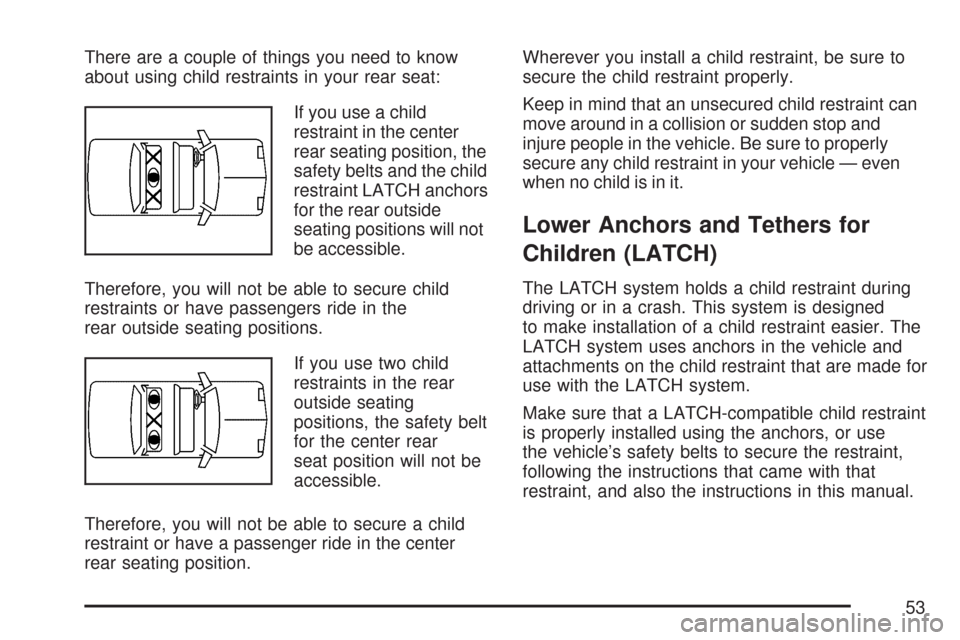
There are a couple of things you need to know
about using child restraints in your rear seat:
If you use a child
restraint in the center
rear seating position, the
safety belts and the child
restraint LATCH anchors
for the rear outside
seating positions will not
be accessible.
Therefore, you will not be able to secure child
restraints or have passengers ride in the
rear outside seating positions.
If you use two child
restraints in the rear
outside seating
positions, the safety belt
for the center rear
seat position will not be
accessible.
Therefore, you will not be able to secure a child
restraint or have a passenger ride in the center
rear seating position.Wherever you install a child restraint, be sure to
secure the child restraint properly.
Keep in mind that an unsecured child restraint can
move around in a collision or sudden stop and
injure people in the vehicle. Be sure to properly
secure any child restraint in your vehicle — even
when no child is in it.
Lower Anchors and Tethers for
Children (LATCH)
The LATCH system holds a child restraint during
driving or in a crash. This system is designed
to make installation of a child restraint easier. The
LATCH system uses anchors in the vehicle and
attachments on the child restraint that are made for
use with the LATCH system.
Make sure that a LATCH-compatible child restraint
is properly installed using the anchors, or use
the vehicle’s safety belts to secure the restraint,
following the instructions that came with that
restraint, and also the instructions in this manual.
53
Page 54 of 436
When installing a child restraint with a top tether,
you must also use either the lower anchors or
the safety belts to properly secure the child
restraint. A child restraint must never be installed
using only the top tether and anchor.
In order to use the LATCH system in your vehicle,
you need a child restraint that has LATCH
attachments. The child restraint manufacturer will
provide you with instructions on how to use
the child restraint and its attachments. The
following explains how to attach a child restraint
with these attachments in your vehicle.
Not all vehicle seating positions or child restraints
have lower anchors and attachments or top
tether anchors and attachments.Lower Anchors
Lower anchors (A) are metal bars built into the
vehicle. There are two lower anchors for each
LATCH seating position that will accommodate a
child restraint with lower attachments (B).
54
Page 55 of 436
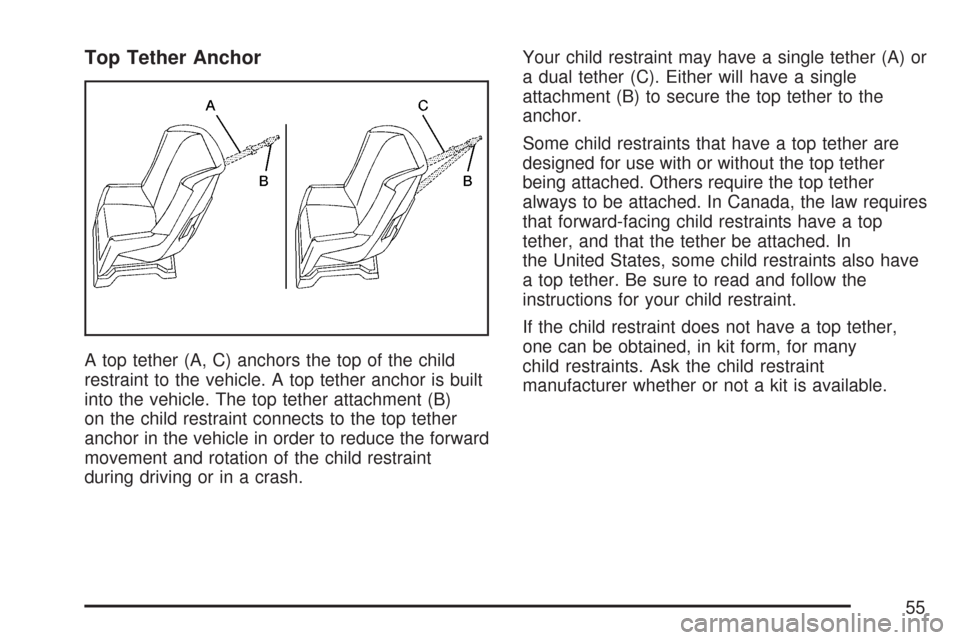
Top Tether Anchor
A top tether (A, C) anchors the top of the child
restraint to the vehicle. A top tether anchor is built
into the vehicle. The top tether attachment (B)
on the child restraint connects to the top tether
anchor in the vehicle in order to reduce the forward
movement and rotation of the child restraint
during driving or in a crash.Your child restraint may have a single tether (A) or
a dual tether (C). Either will have a single
attachment (B) to secure the top tether to the
anchor.
Some child restraints that have a top tether are
designed for use with or without the top tether
being attached. Others require the top tether
always to be attached. In Canada, the law requires
that forward-facing child restraints have a top
tether, and that the tether be attached. In
the United States, some child restraints also have
a top tether. Be sure to read and follow the
instructions for your child restraint.
If the child restraint does not have a top tether,
one can be obtained, in kit form, for many
child restraints. Ask the child restraint
manufacturer whether or not a kit is available.
55
Page 58 of 436
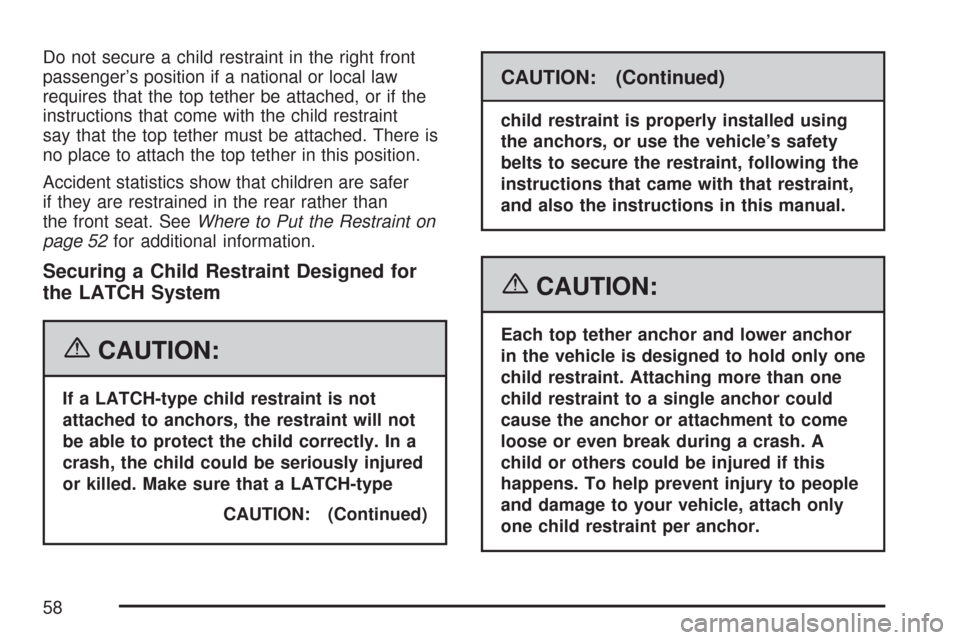
Do not secure a child restraint in the right front
passenger’s position if a national or local law
requires that the top tether be attached, or if the
instructions that come with the child restraint
say that the top tether must be attached. There is
no place to attach the top tether in this position.
Accident statistics show that children are safer
if they are restrained in the rear rather than
the front seat. SeeWhere to Put the Restraint on
page 52for additional information.
Securing a Child Restraint Designed for
the LATCH System
{CAUTION:
If a LATCH-type child restraint is not
attached to anchors, the restraint will not
be able to protect the child correctly. In a
crash, the child could be seriously injured
or killed. Make sure that a LATCH-type
CAUTION: (Continued)
CAUTION: (Continued)
child restraint is properly installed using
the anchors, or use the vehicle’s safety
belts to secure the restraint, following the
instructions that came with that restraint,
and also the instructions in this manual.
{CAUTION:
Each top tether anchor and lower anchor
in the vehicle is designed to hold only one
child restraint. Attaching more than one
child restraint to a single anchor could
cause the anchor or attachment to come
loose or even break during a crash. A
child or others could be injured if this
happens. To help prevent injury to people
and damage to your vehicle, attach only
one child restraint per anchor.
58
Page 59 of 436
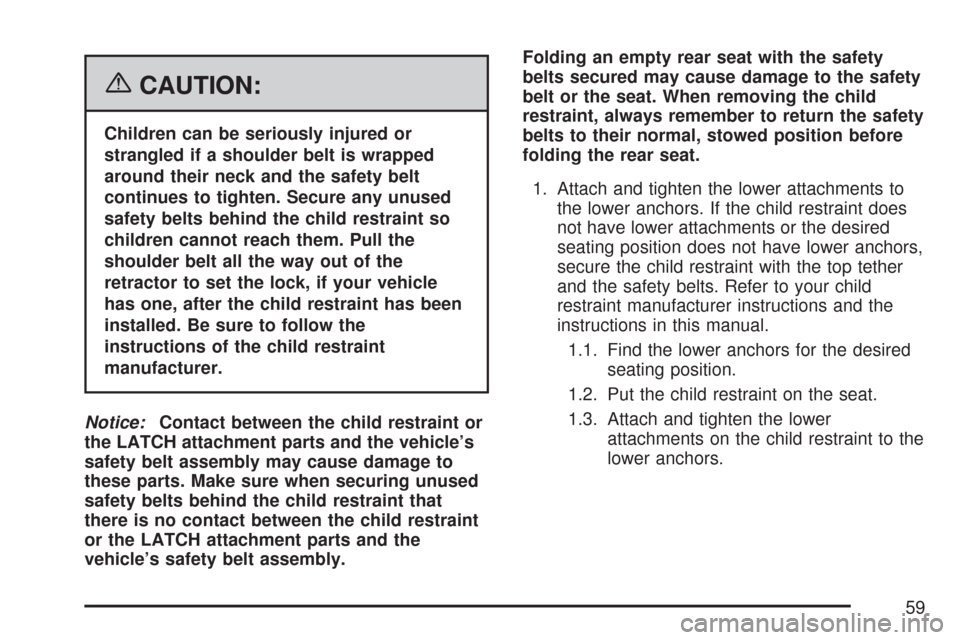
{CAUTION:
Children can be seriously injured or
strangled if a shoulder belt is wrapped
around their neck and the safety belt
continues to tighten. Secure any unused
safety belts behind the child restraint so
children cannot reach them. Pull the
shoulder belt all the way out of the
retractor to set the lock, if your vehicle
has one, after the child restraint has been
installed. Be sure to follow the
instructions of the child restraint
manufacturer.
Notice:Contact between the child restraint or
the LATCH attachment parts and the vehicle’s
safety belt assembly may cause damage to
these parts. Make sure when securing unused
safety belts behind the child restraint that
there is no contact between the child restraint
or the LATCH attachment parts and the
vehicle’s safety belt assembly.Folding an empty rear seat with the safety
belts secured may cause damage to the safety
belt or the seat. When removing the child
restraint, always remember to return the safety
belts to their normal, stowed position before
folding the rear seat.
1. Attach and tighten the lower attachments to
the lower anchors. If the child restraint does
not have lower attachments or the desired
seating position does not have lower anchors,
secure the child restraint with the top tether
and the safety belts. Refer to your child
restraint manufacturer instructions and the
instructions in this manual.
1.1. Find the lower anchors for the desired
seating position.
1.2. Put the child restraint on the seat.
1.3. Attach and tighten the lower
attachments on the child restraint to the
lower anchors.
59
Page 61 of 436
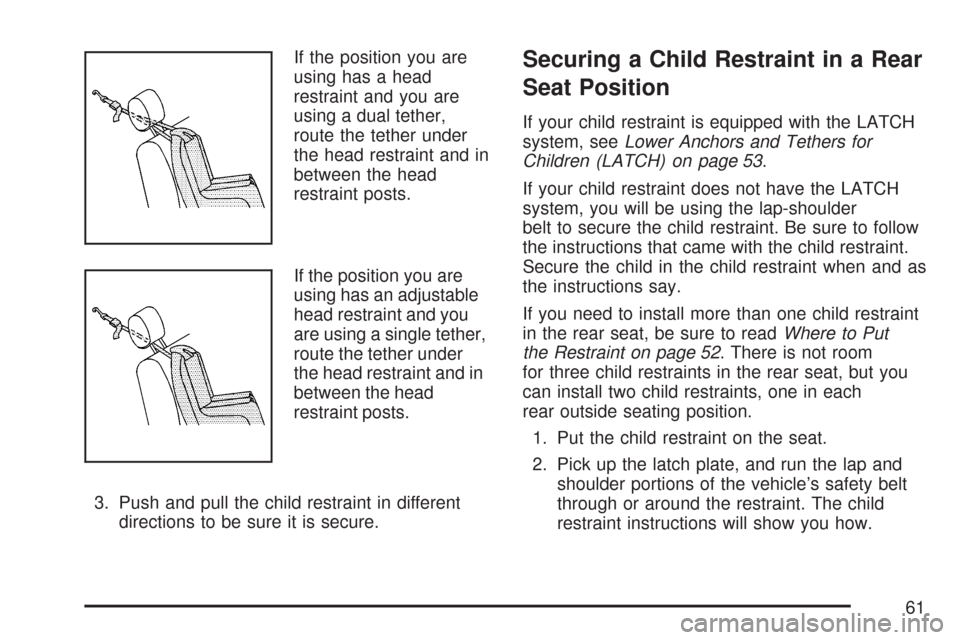
If the position you are
using has a head
restraint and you are
using a dual tether,
route the tether under
the head restraint and in
between the head
restraint posts.
If the position you are
using has an adjustable
head restraint and you
are using a single tether,
route the tether under
the head restraint and in
between the head
restraint posts.
3. Push and pull the child restraint in different
directions to be sure it is secure.Securing a Child Restraint in a Rear
Seat Position
If your child restraint is equipped with the LATCH
system, seeLower Anchors and Tethers for
Children (LATCH) on page 53.
If your child restraint does not have the LATCH
system, you will be using the lap-shoulder
belt to secure the child restraint. Be sure to follow
the instructions that came with the child restraint.
Secure the child in the child restraint when and as
the instructions say.
If you need to install more than one child restraint
in the rear seat, be sure to readWhere to Put
the Restraint on page 52. There is not room
for three child restraints in the rear seat, but you
can install two child restraints, one in each
rear outside seating position.
1. Put the child restraint on the seat.
2. Pick up the latch plate, and run the lap and
shoulder portions of the vehicle’s safety belt
through or around the restraint. The child
restraint instructions will show you how.
61
Page 63 of 436
5. To tighten the belt, push down on the child
restraint, pull the shoulder portion of the belt
to tighten the lap portion of the belt and
feed the shoulder belt back into the retractor.
If you are using a forward-facing child
restraint, you may find it helpful to use your
knee to push down on the child restraint
as you tighten the belt.6. If your child restraint manufacturer
recommends using a top tether, attach and
tighten the top tether to the top tether anchor.
Refer to the instructions that came with the
child restraint and toLower Anchors and
Tethers for Children (LATCH) on page 53.
7. Push and pull the child restraint in different
directions to be sure it is secure.
To remove the child restraint, if the top tether is
attached to the top tether anchor, disconnect
it. Unbuckle the vehicle’s safety belt and let it go
back all the way. The safety belt will move
freely again and be ready to work for an adult or
larger child passenger.
63
Page 64 of 436
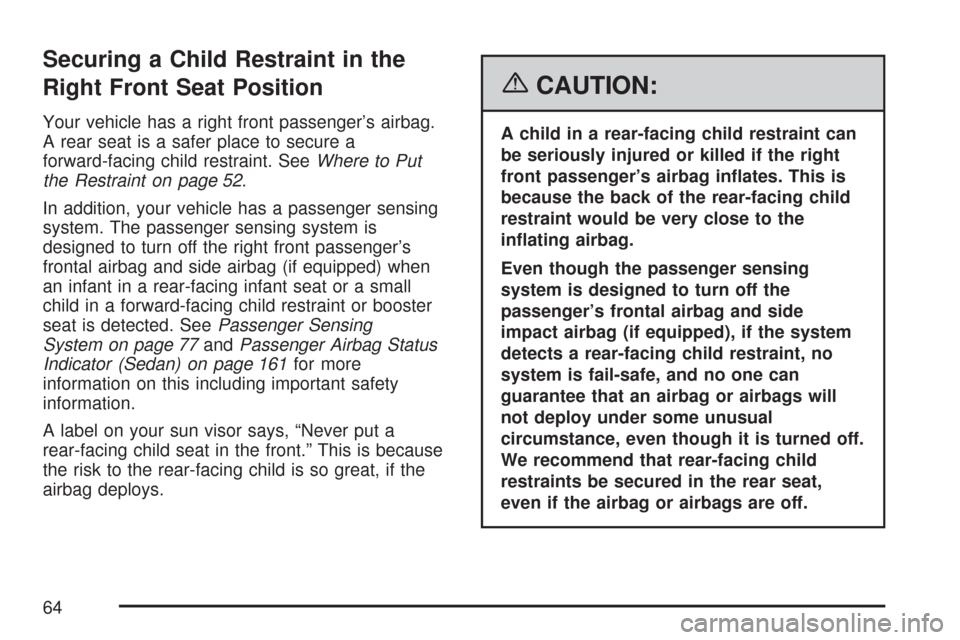
Securing a Child Restraint in the
Right Front Seat Position
Your vehicle has a right front passenger’s airbag.
A rear seat is a safer place to secure a
forward-facing child restraint. SeeWhere to Put
the Restraint on page 52.
In addition, your vehicle has a passenger sensing
system. The passenger sensing system is
designed to turn off the right front passenger’s
frontal airbag and side airbag (if equipped) when
an infant in a rear-facing infant seat or a small
child in a forward-facing child restraint or booster
seat is detected. SeePassenger Sensing
System on page 77andPassenger Airbag Status
Indicator (Sedan) on page 161for more
information on this including important safety
information.
A label on your sun visor says, “Never put a
rear-facing child seat in the front.” This is because
the risk to the rear-facing child is so great, if the
airbag deploys.
{CAUTION:
A child in a rear-facing child restraint can
be seriously injured or killed if the right
front passenger’s airbag in�ates. This is
because the back of the rear-facing child
restraint would be very close to the
in�ating airbag.
Even though the passenger sensing
system is designed to turn off the
passenger’s frontal airbag and side
impact airbag (if equipped), if the system
detects a rear-facing child restraint, no
system is fail-safe, and no one can
guarantee that an airbag or airbags will
not deploy under some unusual
circumstance, even though it is turned off.
We recommend that rear-facing child
restraints be secured in the rear seat,
even if the airbag or airbags are off.
64